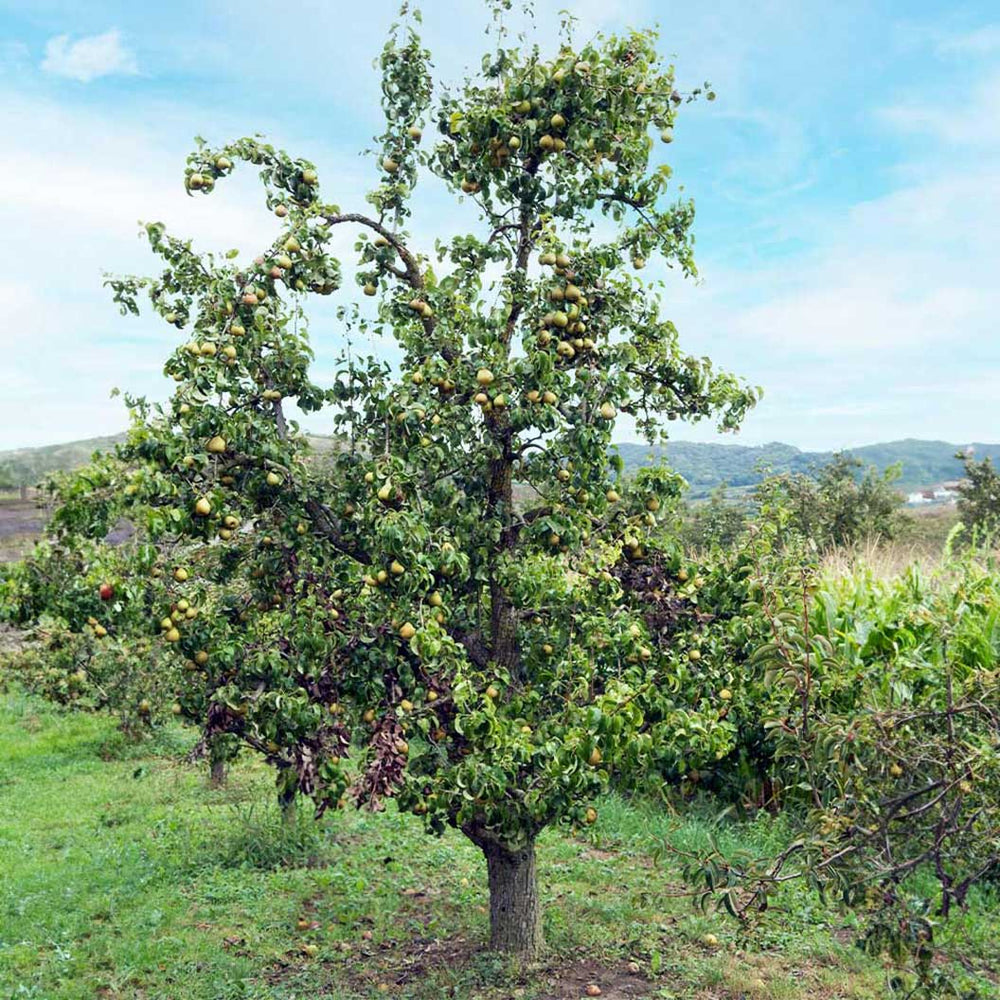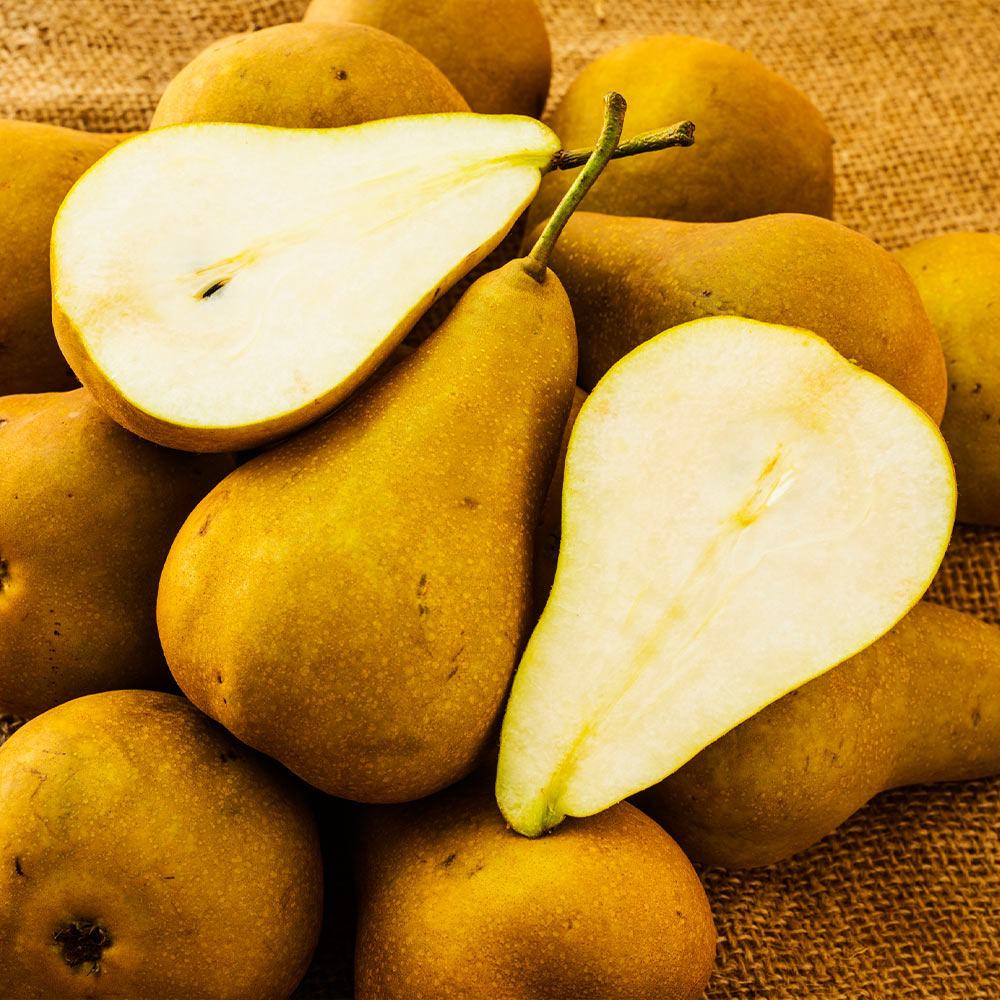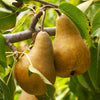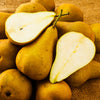* Images shown are of mature plants

Have questions? Talk with our Plant Experts (800) 973-8959
Save 25% on $200+ with code FALL25.
Questions? Call our plant experts: (800) 973-8959
The Grand-Daddy of All Pears!
If you are looking for a pear tree that will provide fruit, long after the other varieties have gone to sleep . . .
You will want to plant the Bosc Pear.
The fruit of this luscious tree is ready for harvest after the Autumn Equinox, giving it the nickname 'Winter Pear'. Its 'Fall Harvest' will add a special dimension to your landscape and properly cared for, this hardy tree will produce for up to 100-years.
Your Bosc Pear blooms in mid-April, filling your tree with lovely white blossoms and your senses with its' delicate fragrance. The fruit will develop abundantly and slowly over the summer; ready for harvest in late September.
The wonderful thing about the Bosc Pear is that it 'sweetens' early, even before the fruit begins to soften; this means that you can enjoy it, right off the tree.
The skin color won't change much during the ripening process but you can test the ripeness by simply pressing your thumb around the top of the pear, near the stem; if it gives just a little - the Bosc Pear is ripe. It will never become as soft as some other varieties and that's what makes it so special.
The Bosc Pear stands out for many reasons: Its fruit is quite large, with a rounded bottom - tapered middle - and long, slender neck, giving it a shape that sets it apart. The subtle gold undertone of its skin is covered with a cinnamon brown russeting which creates a dynamic visual appeal.
Your Bosc Pear will have a unique taste and texture; Slightly acidic and lightly spicy - Tantalizing your taste buds and bringing you back for more. The white flesh of the Bosc is firm but juicy, crunchy and yet tender . . . it is perfect for eating fresh and fabulous for cooking.
Try adding the Bosc Pear to salads, poaching it for desserts, or adding it to your fruit baskets as a focal point. You won't soon forget its' rich flavor - or its' buttery sweetness.
- Low Maintenance
- Abundant Producer
- Large Fruit
- Provides Winter Fruit
- High in Vitamin-C and Dietary Fiber
- Naturally Shaped Oval Canopy
The Bosc Pear sells Quickly . . . Order Yours TODAY !
Pollination Info
Bosc Pear Pollination
Bosc Pears are not self-fertile. You will need to plant another variety to achieve fruiting. Below are the most effective pollinators we have chosen for your area...
Planting & Care
The Bosc Pear tree (Pyrus communis 'Bosc') is a semi-dwarf, full sun loving, cold hardy fruit tree that produces an abundance of large cinnamon brown colored pears. This fast growing pear tree is commonly planted in USDA growing zones 4-9 reaching heights of 12-15 feet tall/wide at their maturity. Mid-April brings forth a flurry of lovely white blossoms that give way to a uniquely shaped, sweet fruit in September that you can pick right off of the tree and enjoy. Since the skin color doesn’t change much as it ripens you will want to use your thumb to give it a little “press” near the stem. Bosc pears do not get soft like most other pears at maturity but there should be a slight give to the press indicating ripe fruit. The Bosc pear is not self-fertile so you will require a cross pollinator for the fruit to set (see pollination partners below).
Location: Give your pear tree a location that features full sun and well-draining soil. Choose a bright, sheltered location, preferably with southern exposure.
Planting Instructions (in ground):
1) Dig a hole three times the size and just as deep as the root ball. You want to be careful that the tree does not settle too low in the soil.
2) After the hole is dug, carefully loosen and unwind any roots as necessary.
3) Plant the tree so that the roots are spread in the hole and the entire root ball is covered with soil.
4) Fill in the hole completely and gently remove air pockets that may have formed by tamping down with a spade.
5) Water the tree thoroughly after the tree has been planted.
Planting Instructions (potted):
1) Select a container that has adequate drainage holes in the bottom and is at least 2 sizes larger than the pot it arrived in.
2) Remove the tree from it’s original container taking care not to damage the root system, put a few inches of soil in the bottom and place it into the pot.
3) Use a good potting medium such as Miracle grow to fill in the open space around the root ball, tamping down slightly as you go to prevent any air pockets from forming.
4) Water the tree to settle the soil and then make sure it’s in a location where it will receive 6+ hours of direct sun everyday.
Watering: Water your pear tree as necessary giving it at least 1 or 2 inches of water once a week. When the weather gets hot and dry during the peak of summer, increase the amount of water to maintain proper hydration and moisture. Do not water the pear tree after the first frost in the fall. You should resume watering once the last frost has past. For potted pear trees, water once the top two inches of soil has dried. Using your index finger is a good way to determine if there is still any moisture present in the soil. Provide enough water until you see it escaping the drainage holes and then stop.Take care to never over water your pear tree, they are very susceptible to root rot.
Pruning: When pruning, it’s important to trim the pear tree's central leader to promote an upright position. If there are any competing branches present, remove them so that multiple leaders do not form. Maintain the tree’s natural shape by pruning large, lateral branches. Dead, dying or wilted branches should always be removed to help the Pear Tree focus its energy on growing healthy and producing an abundance of fruit. Potted pears can be pruned any time.
*Tip* It’s always good to sterilize your cutting tool(s) with rubbing alcohol to ensure a clean cut that no pathogens can get into.
Pests: Pear trees are susceptible to insects such as maggots, moths, scale and aphids. To prevent infestation of these and other pests, treat with an insecticide in the early spring. Signs of infestation to be watchful for include yellowing or browning of foliage, rotted or eaten fruit and nibbled leaves. Spray the tree with the insecticide according to the directions on the label.
Tips:
*Harvest pears at the end of the growing season (September). Watch the fruit regularly, as it will require two to three weeks to harden before harvest.
*Pick pears when they have reached full color and size and are firm to the touch. Check the tree daily and pick fruit every two to three days until your harvest is complete.
Pollination partners:
*Bartlett and D’Anjou pears
Shipping Details
Estimated Shipping Time: Most orders ship immediately. As noted on the website, some items are seasonal, and may only ship in spring or fall. Once your order is shipped, you'll receive an email with a tracking number.
| Amount of Order | Shipping Charge |
|---|---|
| Less than $49 | $19.95 |
| $49 + | FREE SHIPPING! |
Product Details
| Mature Height: | 12-15 ft. |
| Mature Width: | 12-18 ft. |
| Sunlight: | Full Sun |
| Growth Rate: | Fast |
| Harvest Time: | September |
| Year to Bear: | Can Fruit the 1st Year! |
| Botanical Name: | Pyrus communis 'Bosc' |
| Does Not Ship To: | AR,AZ,CA,ID,LA,OR,WA |
| Grows Well In Zones: | 4-9 outdoors |
| Your Growing Zone: | # |









